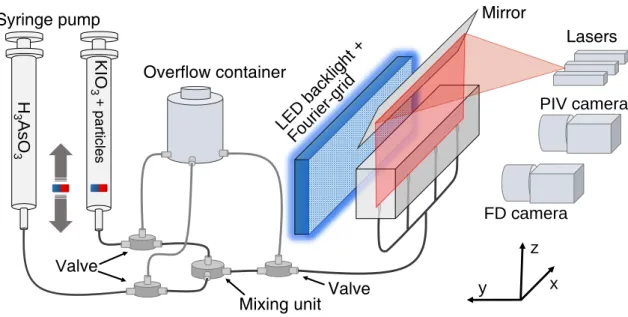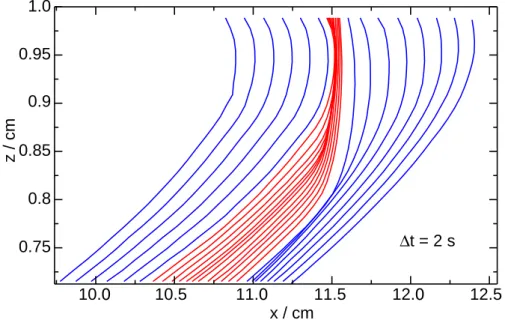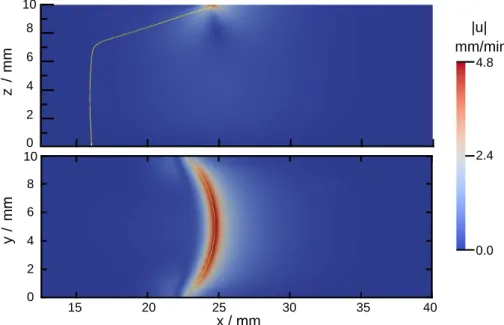CHEMO-HYDRODYNAMIC INSTABILITIES UNDER
MICROGRAVITY
Theses of doctoral (PhD) dissertation
Péter Bába
Supervisor: Dr. Dezs˝o Horváth, full professor
Doctoral School of Environmental Sciences
University of Szeged
1 Introduction and Aims
There are numerous examples of transport phenomena in our environment which have funda- mental effects on our every day life. To identify and understand the various modes of transports is essential in making accurate forecasts. One mode of material transport coupled to fluid flow is called advection. Fluid flow is generated by gradients in intensive properties such as pressure, velocity, surface tension and density. In reactions with positive feedback, which are commonly investigated in the field of nonlinear dynamics, the interaction between the autocatalytic re- action and the transport processes creates a thin interface where the reaction takes place. The chemical front separates two fluids with different physical properties leading to unstable strati- fication. The instability generated by the difference in solutal density is the so called Rayleigh–
Taylor-instability, while in the presence of gradient in surface tension Marangoni-instability may develop. Both instabilities induce fluid flow. The enhanced fluid motion may distort the shape of the reaction front and affect the velocity of the propagating front. Since the reaction front is self-sustaining, the generated gradients are constant during the reaction, therefore these systems are excellent to investigate hydrodynamic instabilities.
The aim of my work was to characterize the fluid flow generated by Rayleigh–Taylor- and Marangoni-instabilities in the iodate-arsenous acid (IAA) system. Since the two instabilities are present simultaneously under terrestrial conditions, one has to eliminate the intense flow originating from buoyancy to investigate the effect of Marangoni-instability solely. Therefore experiments have to be conducted in microgravity. I carried out investigation during parabolic flights in a modulated gravity field, and on board of the MASER-13 sounding rocket which provided six minutes of pure microgravity. In the former I aimed the study of Rayleigh–Taylor- instability and the fine tuning of experimental parameters for the rocket flight. In the frame of the MASER-13 campaign, only the effect of Marangoni-instability has been investigated. In the latter besides describing the spatiotemporal evolution of the reaction front, the velocity of the generated fluid flow has been determined by the non-intrusive particle image velocimetry (PIV) technique.
For a fully detailed three-dimensional characterization of the generated fluid flow, numerical simulations have also been conducted. I have developed a universal reaction-diffusion-advection model in the OpenFOAM software. Solving Navier–Stokes-equations coupled with the differ- ential equations which are represent the mechanism of the examined reaction, the concentration distribution of the species can be obtained apart from the velocity and pressure field.
2 Experimental Section
I have carried out experiments using the iodate-arsenous acid reaction. The ratio of the ini- tial concentration of the reactants R = [H3AsO3]0/[IO3]0=2.8, at which the most of the sur- face active iodine is produced without the disturbing effect of its evaporation, were selected.
For both the parabolic flights and sounding rocket experiments, the initial concentrations of 36.1 mmol/dm3 and 12.9 mmol/dm3 were set for the arsenous acid and iodate ion, respec- tively. The reaction was initiated by applying an electric potential difference on two platinum wires. During the parabolic flights one of the experimentally tuned parameters was the elec- tric potential difference which was varied between 3 V and 5 V, while for the sounding rocket experiment 5 V was applied for 4 seconds. The Rayleigh–Taylor-instability was investigated in cells fully filled with liquid as illustrated in Fig. 1. In the sounding rocket experiment, cells
Lx = 8.0 cm
Lz = 1.0 cm
(a) (b)
(d)
Lx = 16.0 cm
(c)
Ly = 0.5 - 1.0 cm
Ly = 0.5 - 1.0 cm Lz =1.0 cmLz =1.0 cm
Figure 1. The geometry and dimensions of the cells used during the parabolic flight experiment.
The cross section of the cell with the possibility of creation free liquid-gas interface in the xz- plane (a), in theyz-plane (b), the cross section of the fully filled cells in thexz-plane (c) and in theyz-plane (d).
with 7.5 cm of length (see Fig. 1.(a,b)) were used, where platinum wires were built parallel to thez-axis. The cells are made of plexiglass and quartz during the parabolic flights, while in the case of the sounding rocket campaign only quartz cells were used. The filling of the cells were conducted with syringe pumps. The filling process was tested in hypergravity, microgravity and in normal gravity as well. However, for the rocket experiment, the cells were filled only in the microgravity phase of the flight.
The spatiotemporal evolution of the reaction front was monitored with monochrome cam- eras in both experiments. During the parabolic flight only one camera was applied (see Fig.
2) for recording images while the cells were changed manually by the operator in front of the camera. During the rocket campaign two cameras were used for each cell, which recorded im-
x y
z KIO3
H3AsO3 Syringe pump
CCD camera
Reaction cell
Valve
+
–
Mixing unit
backlightLE
Figure 2. Schematic diagram of the experimental setup used for the parabolic flights.
ages in the xz-plane as shown in 3. One camera captured the actual shape and position of the reaction front, while the other one was the part of the PIV technique with 3-3 lasers. These light sources were operated according to a program individually shining the light scattering particles along thexz-plane of the cells with 1.5 mm offset. Non-settling particles with 6.4µm of diam- eter were introduced in the cells together with the liquid which contained the iodate ions. The concentration of the particles was 36µg/cm3in the reactant solutions.
KIO3+ particlesrészeék
H3AsO3
Syringe pump
Mixing unit Valve
Overflow container
Mirror
Lasers
y
z x
PIV camera
FD camera
Valve LED
backlight + Fourier-grid
Figure 3. Schematic figure of the setup used for the sounding rocket experiment.
3 Numerical Simulation
The shape of the reaction front could only be investigated experimentally from the side view, along the xz-plane. In order to gain more detailed description about the front evolution, a reaction-diffusion-advection model was created which is able to calculate the fluid flow gen- erated by both the Rayleigh–Taylor-instability and the Marangoni-instability. The model was implemented in the open-source software called OpenFOAM. The PIMPLE solver was coupled with an algorithm which computes the concentration field of the reacting species. The conser- vation equations of momentum and mass with finite volume discretization method were solved.
To describe the fluid flow, the Navier–Stokes-equations are solved with applying the Boussi- nesq approximation where density change due to temperature and compositional changes can be calculated, while the fluid is considered incompressible in general. The change in the con- centration of the species due to the reaction is calculated with the CVODE algorithm using the empirical rate laws of the Dushman and Roebuck reactions with the appropriate rate constants.
On the boundary which represented the liquid-air interface, a Marangoni boundary condition was applied to implement the fluid flow generated by the surface tension gradient.
4 New Scientific Results
I. We have shown by measuring the front velocity in a modulated gravity field that the Rayleigh–Taylor- and Marangoni-instabilities are present independently in the iodate–
arsenous acid system and their effect on the front characteristics are superimposed.[4]
The fluid flow generated by the instabilities in the IAA-system can be qualitatively charac- terized by exploring the properties of the reaction front. The Marangoni-instability can be eliminated by running the reaction in the absence of liquid surface, therefore fluid motion generated purely from Rayleigh–Taylor-instability can be observed. Figure 4 shows that the velocity of the spreading reaction front monotonically increases with the increasing gravitational acceleration. Furthermore, under microgravitational conditions, the veloc- ity of front propagation in the absence of liquid-air interface is the same as that of pure reaction-diffusion fronts.
0.0 0.5 1.0 1.5 2.0
gz / g
0
0.0 0.01 0.02 0.03 0.04 0.05 0.06
v/cm/s
closed surface open surface
Figure 4. Velocity of front propagation as a function of gravitational acceleration for various cell types.
For identical chemical composition, higher front velocities are observed in reaction vessels with liquid–gas surface than in those without. This increase in the front velocity is due to the fluid flow generated by the surface-tension difference along the interface.
II. Upon elimination of the buoyant forces, and hence the Rayleigh–Taylor-instability due to density change, in microgravity, the propagation of the reaction front can only be affected by reaction-diffusion for the fully filled cells.[4]
In the absence of an open liquid surface, the propagation velocity decreases to the velocity of pure reaction-diffusion front. In hypergravity the front propagates with constant shape and velocity as in Fig. 5. During the microgravity phase, buoyancy is reduced by several orders of magnitude meanwhile significant decrease in the front velocity is observed. By eliminating the fluid flow, the propagation of the reaction front is only driven by the rate of diffusion of the autocatalytic species. The curvature of the front with concave shape specific to the upper part of the front begins to decrease. Once the airplane enters to hy- pergravity phase, both the shape and the front velocity changes back to the one observed during the presence of increased buoyancy.
10.0 10.5 11.0 11.5 12.0 12.5 x / cm
0.75 0.8 0.85 0.9 0.95 1.0
z/cm
∆t = 2 s
Figure 5. Spatiotemporal evolution of front profiles with∆t = 2 s for a reaction front propagating left to right in the absence of liquid-air interface. The blue lines represent the front shapes recorded in hypergravity phases while the red lines the shapes in microgravity.
III. Pure Marangoni-instability has been observed in the IAA system in microgravity, where the distorting effects of convection are limited only to the vicinity of the liquid-air inter- face.[2]
In microgravity provided by the MASER rocket, only reaction cells with the possibility of liquid-air interface were used. Following the initiation in microgravity, the reaction front propagates with preserving its initial shape. The distorting effect of fluid flow, which is typical in the presence of Rayleigh–Taylor-instability, is not observed. However, after a 40–50 second–long transient period, in the vicinity of the liquid-air interface, the reaction front starts to tilt along the direction of its propagation. Then the front preserves its shape which is characterized by two linear segments (see Fig. 6). It has been shown that the font propagates with the reaction-diffusion front velocity everywhere except at the liquid- air interface. Besides Marangoni-instability, no other phenomena affecting the front shape
are observed. 1 cm
1 cm 1 cm L = 0.5 cmy
L = 1.0 cmy
Figure 6. The recorded image of the reaction front during the sounding rocket experi- ment in the 10 mm wide cell.
The motion of the light scattering particles reveals a convection ring rotating in the direc- tion of front propagation. The velocity field shows that the vortex is highly asymmetric.
The center of the convection ring is 3 mm far from the surface where the flow velocity decreases one order of magnitude. There is no further decrease in the particles’ velocity in the rest of the cell.
The fact, that the front propagation velocity differs from the reaction-diffusion front veloc- ity only at the liquid-air interface proves that the distortion in the fronts shape is caused by Marangoni-instability. The analysis of the motion by PIV particles shows that significant fluid flow is only generated at the liquid-air interface by the Marangoni-instability and has no effect on the propagation of the front elsewhere.
IV. The shape of the reaction front in the xz symmetry-plane can be reconstructed with a model based on the laws of wave propagation, which considers reaction-diffusion fronts everywhere, except at the liquid-air interface.[2]
Since the fluid flow can be neglected in the bulk of the fluid, the two dimensional be- haviour of the reaction front can be described with a simple geometric spreading model.
In particular, front position is considered as a series of points of wave sources. If waves are initiated with their characteristic velocities, the evolving front shape and position are depicted by the envelope of the waves at a given time. The distortion due to the surface tension change is considered as one moving point source on the surface traveling with the velocity of the flow. The front shape and position obtained by this model are in good agreement with both the experimental front profiles and the calculated ones as illustrated in Fig. 7.
0.5 1.0 1.5 2.0 2.5 3.0
x / cm 1.0
0.8 0.6 0.4 0.2 0.0
z / cm
Ly = 1.0 cm
Figure 7. Front evolution with∆t = 14.95 s during the sounding rocket experiment in the 10 mm wide cell and three front shapes (dashed lines) calculated by geometrical spreading.
V. A solver algorithm was implemented in the OpenFOAM software, which can be applied universally to any reaction-diffusion-advection systems, with which the observed experi- mental front characteristics are reproduced and extended to three spatial dimensions.[1,3]
Detailed velocity, pressure and concentration fields of the discretized space can be deter- mined with our reaction-diffusion-advection model for any time. The shape of the front can also be characterized by two linear sections along thexz-plane in accordance with the experimental observations. The segment which has the same orientation as the wires used for front initiation propagates with similar velocity as the pure reaction-diffusion front, while the upper section tilts to the direction of front propagation. The velocity field ex- hibits a strongly asymmetric vortex which has its center of rotation under the tip of the front and rotates in the direction of front propagation.
15 20 25 30 35 40 0
2 4 6 8 10
y/mm
x / mm
z/mm
0 2 4 6 8 10
|u|
mm/min 4.8
2.4
0.0
Figure 8. The velocity flow field and the front shape (yellow line) in thexz-plane along the centerline of the cell (top) and in thexy-plane of the fluid-gas interface (bottom) as a result of the fluid dynamic calculations.
The fluid velocity in this case also decreases to the fraction of the value calculated on the surface in two-three millimeters. Under the center of the convection ring, where the direction of the flow is opposite, the velocity is only 10-20% of the velocity of the reaction- diffusion front. In the xy-plane the velocity field has a parabolic profile characteristic to laminar fluid flow between parallel rigid walls. Similar tendency is observed for the ve-
5 List of Scientific Publications related to the subject of the dissertation
1. P. Bába, Á. Tóth, D. Horváth
Surface tension-driven dynamic contact line in microgravity Langmuir,35 (2), pp. 406–412 (2019).
IF2018= 3.789
2. P. Bába, L. Rongy, A. De Wit, M. J. B. Hauser, Á. Tóth, D. Horváth
Interaction of pure marangoni convection with a propagating reactive interface under microgravity
Phys. Rev. Lett.,121, pp. 024501-1–6 (2018).
IF2017= 8.839
3. P. Bába, Á. Tóth, D. Horváth
Autokatalitikus frontreakciók konvektív instabilitásának numerikus vizsgálata Alkalmazott Matematikai Lapok,33, pp. 129–138 (2016).
IF = –
4. D. Horváth, M.A. Budroni, P. Bába, L. Rongy, A. De Wit, K. Eckert, M. J. B. Hauser, Á.
Tóth
Convective dynamics of traveling autocatalytic fronts in a modulated gravity field Phys. Chem. Chem. Phys.,16 (44), pp. 26279–26287 (2014).
IF2014= 4.49 ΣIF = 17.118
6 Lectures Related to the Dissertation (English)
1. P. Bába, E. Tóth-Szeles, M. Hauser, Á. Tóth, D. Horváth Preliminary results on CDIC-3 experiment
ESA Topical Team Meeting, Brussels (BE), 21–23 March 2016.
7 Lectures Related to the Dissertation (Hungarian)
1. Bába P., Tóth Á., Horváth D.
Kemo-hidrodinamikaiinstabilitások vizsgálata mikrogravitációs környezetben
PhD-értekezés el˝ozetes bemutatása, MTA Reakciókinetikai és Fotokémiai Munkabi- zottsági Ülés, Balatonalmádi (HU), 29–30 May 2017.
2. Bába P., Tóth Á., Horváth D.
Kemo-hidrodinamikaiinstabilitások vizsgálata mikrogravitációs környezetben
PhD-értekezés el˝ozetes bemutatása, Fizikai Kémiai és Anyagtudományi Tanszék Szem- inárium, Szeged (HU), 11 May 2017.
3. Bába P., Horváth D., Tóth Á.
A Marangoni instabilitás vizsgálata mikrogravitációban
MTA Reakciókinetikai és Fotokémiai Munkabizottsági Ülés, Mátraháza (HU), 3–4 November 2016.
4. Bába P., Horváth D., Tóth Á.
Marangoni-instabilitás vizsgálata mikrogravitációban
XXXIX. Kémiai El˝oadói Napok, Szeged (HU), 17–19 October 2016.
5. Bába P., Horváth D., Tóth Á.
Kemo-hidrodinamikai instabilitás vizsgálata mikrogravitációs környezetben XXXVIII. Kémiai El˝oadói Napok, Szeged (HU), 26–28 October 2015.
8 Poster Presentations Related to the Dissertation
1. P. Bába, E. Tóth-Szeles, M. Hauser, Á. Tóth, D. Horváth
Marangoni instability in a propagating autocatalytic reaction front under microgravity 7th ISPS & 25th ELGRA Biennial Symposium and General Assembly, Juan-les-Pins, (FR), 2–6 October 2017.
2. P. Bába, E. Tóth-Szeles, M. Hauser, Á. Tóth, D. Horváth
Marangoni instability in a propagating autocatalytic reaction front under microgravity XXXVII Dynamics Days Europe, Szeged (HU), 5–9 June 2017.
3. P. Bába, E. Tóth-Szeles, M. Hauser, Á. Tóth, D. Horváth
Marangoni instability in a propagating autocatalytic reaction front under microgravity GRC on Oscillations and Dynamic Instabilities in Chemical Systems - Chemical Self- Organization Far from Equilibrium, Stowe (VT), USA, 17–22 July 2016.
4. P. Bába, E. Tóth-Szeles, M. Hauser, Á. Tóth, D. Horváth
Marangoni instability in a propagating autocatalytic reaction front under microgravity
9 Other Poster Presentations
1. P. Bába, P. Adamo, C. Amalfitano, E. Tóth-Szeles
Preliminary studies on growing media alternative to peat
19th International Symposium on Analytical and Environmental Problems, Szeged (HU), 23 September 2013.
2. D. Villecco, P. Adamo, C. Amalfitano, P. Bába, C. Pane, R. Scotti,E. Tóth-Szeles, M.
Zaccardelli
Preliminary studies on growing media alternative to peat in horticulture nursery
XXXI. Convegno Nazionale della Societa Italiana di Chimica Agraria, Napoli (IT), 16–17 September 2013.
MTMT identification number: 10052537






